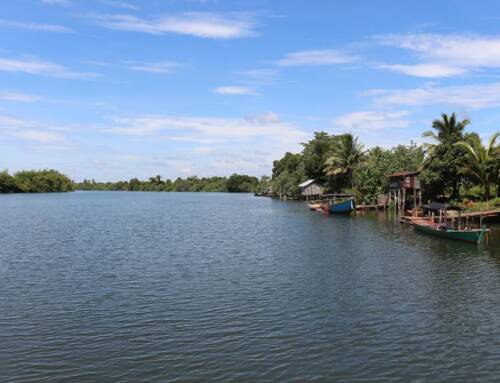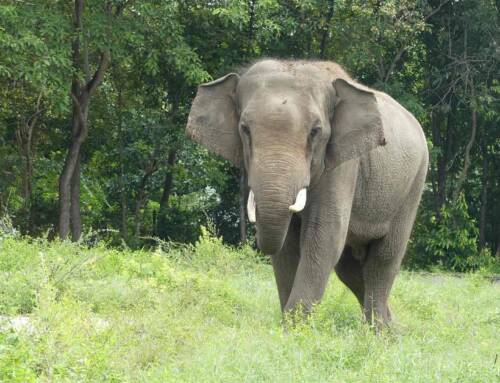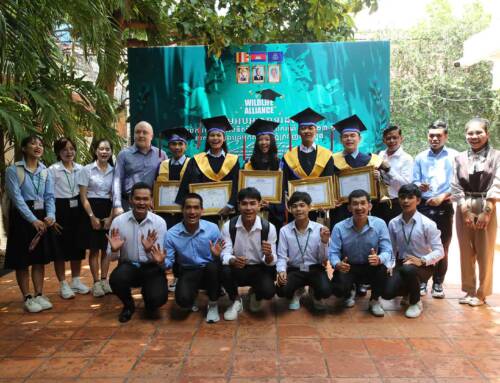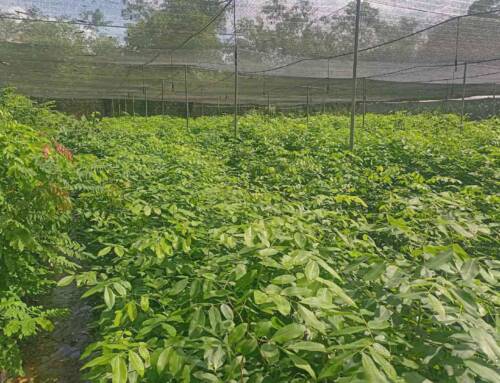In celebration of World Rewilding Day, here’s an update on the latest releases at Angkor, including birds species, Great Hornbill and Green Peafowl!
This year, the Angkor Wildlife Release Project turns nine. Since 2013, over 40 animals have been released at the site, primarily mammals like Pileated Gibbons, Silvered Langurs and Smooth-coated Otters. Last year was the turn of the birds to return to the UNESCO World Heritage site.
Releasing Hornbills and Green Peafowl at Angkor
Cambodia has many large native bird species that would be appropriate for release in Angkor, but Phnom Tamao Wildlife Rescue Centre rarely has sufficient numbers of them for the Forestry Administration to permit their release.
Fortunately, in May 2021, several young adult Green Peafowl (Pavo muticus), as well as Great Hornbill (Buceros bicornis) and Wreathed Hornbill (Rhyticeros undulates), were donated to Wildlife Alliance for release in Angkor. These birds were donated from two sources: a private individual and our Siem Reap based partner, the Angkor Centre for Conservation of Biodiversity (ACCB). These species were once common and widespread throughout Southeast Asia. However, Green Peafowl has been IUCN Red-Listed as Endangered due to very rapid population declines as a result of extremely high hunting levels and intensive habitat conversion, while Great Hornbill and Wreathed Hornbill are both Vulnerable.
On 23 December, after several months of acclimatizing to Angkor in enclosures, the birds were ready for release. This was to reduce the stress experienced by the Great Hornbills whenever people approached their enclosure.
What is rewilding?
Release of wildlife back into their natural home is important for restoration of biodiversity and natural heritage. Recently, Green Peafowl were released at Angkor! This key species is making a comeback at the UNESCO World Heritage site. The release of key species like Pileated Gibbon and Green Peafowl helps to restore the ecosystem at Angkor. Thanks to the support of the Apsara National Authority and the Forestry Administration for enabling the release of over 40 animals as part of the Angkor Wildlife Release Project.
Why release wildlife at Angkor?
Angkor is an ideal site to reintroduce these threatened species because as an UNESCO World Heritage Site it is now one of the only places within their native range that is extremely well-protected from these threats.

How we release birds at Angkor
We released the birds 4 Green Peafowl, 4 Wreathed Hornbills, and 6 Great Hornbills by opening the trap doors high on the sides of the two Hornbill enclosures and the main doors for the Peafowl to make their exit. Gradually all the birds left.
Since these birds were soft-released, food baskets were hoisted high into the trees for the Hornbills and placed on the ground outside the release enclosure for the peafowl and supplementary food – fruit, chicken feed and dog food (for protein) – is provided twice each day. The peafowl return singly to feed, but it does not look like they all come back every day, so to some extent they must be finding their own food in the forest. The portions may be reduced over time as the birds learn to forage and live in the forest. However, supplementary feeding in Angkor is also a management technique that encourages released animals to remain in more heavily forested areas of the Park, away from human traffic, and enables us to monitor their survival and any offspring that are produced.
While soft releases were appropriate for these birds that hard been acclimatising for much of 2021, the method is not appropriate in all cases. On 24 December, another 4 Green Peafowl that were captive-bred at ACCB were hard-released by Wildlife Alliance and ACCB staff at Lake Santamea, a wild and less visited site within Angkor Thom. These peafowl were extremely nervous and would have fared poorly inside an enclosure. They left immediately and have not been seen again, although peafowl calls are now heard from time to time in the forest.
In January 2022, ACCB donated another single female for release. She was placed in an enclosure at the birds’ soft-release site and one of the released males soon began coming to visit her regularly. She has now been released as she was clearly unhappy inside the enclosure. She is still seen occasionally accompanying the visiting male.

What next for birds release at Angkor?
Since their release, supplementary feeding continues and the birds are being monitored. We are happy to report that all has gone well so far. Now and again we receive reports of a Wreathed or Great Hornbill flying over Angkor Wat and the peafowl are sometimes seen from the road. With a mix of both male and female Green Peafowl and Great Hornbills released, we hope these founding birds may eventually establish new breeding populations in Angkor!

A brief history of wildlife at Angkor
The ancient forests of the Angkor Archeological Park once teemed with a great diversity of wildlife but populations were decimated by over-hunting at the end of the last century. The aim of our Angkor Wildlife Release Project is to repopulate Angkor with a cross-section of native species using animals rescued from the illegal wildlife trade or the captive-bred offspring of rescued animals. Since 2013, Wildlife Alliance has released Pileated Gibbons, Silvered Langurs, Red Muntjac, Smooth-coated otters, Leopard Cats and Oriental Pied Hornbills into Angkor, many of which have gone on to raise wild-born offspring in the forest.
Read more about the Angkor Wildlife Release Project here




